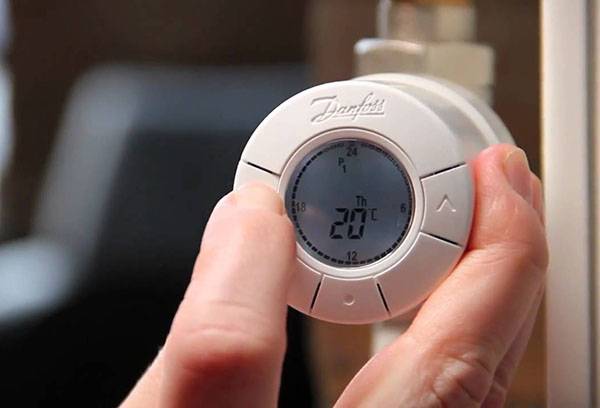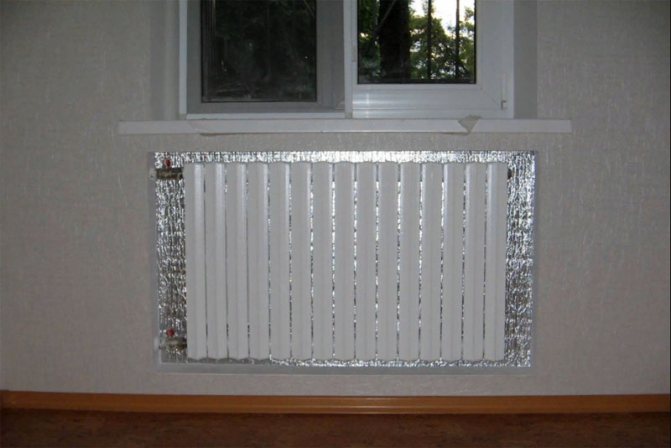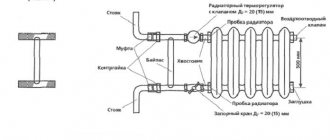The simplest way
Cast iron radiators, widely used in typical apartments, are the best way to heat living quarters. However, such heating devices also have their drawbacks, mainly due to the lack of a thermostat and an excessively high return of stored energy. You can consider ways to optimize the operation of cast iron radiators, if any in your apartment.
The simplest and most effective material for eliminating excessive heat transfer from a cast-iron battery is an ordinary blanket placed on the radiator planes. Close the battery with them will be a matter of seconds for you. The possible predictable skepticism of many Internet users is associated, first of all, with a poor knowledge of the physical processes described in the school curriculum.
Reduced indoor humidity will be a minor side effect. It can be easily eliminated by purchasing an air humidifier (its average consumption in a typical apartment is up to three liters of water per day) and a psychrometer - a device that controls the level of humidity in the room.
Advice
Do not use the vents as a way to lower the room temperature, they can only be opened to naturally ventilate the room. Otherwise, the presence of very dry air in the apartment can lead to unpleasant consequences for the nasopharynx and skin. At the same time, the heat escaping from the room will not significantly reduce the degree of warming up.
The rationale for this advice lies in the physical processes that occur when cold street air enters the apartment. This air, which has a low level of humidification, heats up, passing through the window into the room, and reduces the absolute value of humidification. Accordingly, an increase in the humidity of the apartment atmosphere will occur with the help of your breath and skin, taking away the water it needs from the body.

Do radiators affect heat consumption?
The higher the heat dissipation of the radiator, the better the room heats up and, accordingly, the less heat consumption. The level of heat transfer is indicated in the technical data sheet of the device. For example, for aluminum radiators it is 135-145 W / kg, and for bimetallic - 90-100 W / kg.
You should refrain from buying batteries made in China. Often, the actual heat transfer of these devices is significantly lower than that stated in the documents. That is, heat bills will be higher than expected. And in the worst case, it will be cold in the apartment, so you will have to buy additional sections of radiators.
The volume of water that the radiator uses is also important. For example, to heat a room with a classic cast-iron battery, an average of 2 liters of water per section is needed due to its size and low heat transfer. An aluminum or bimetallic radiator with high heat transfer requires only 500-600 ml of water per section to heat the same room.
The text was prepared by Alexandra Lavrisheva
Alternative ways
One of the alternative ways to protect against excessive heat in a residential area is to purchase and install a special valve. Such a simple device allows you to regulate the level of heat supplied to the battery and save its value in ruble terms. The principle of saving becomes important for apartment owners, since heat distribution will become possible depending on atmospheric conditions.
The current state of the market for plumbing fixtures and fittings makes it possible to purchase a special protective screen operating on the principle of blinds.One turn of the shutters of such a screen helps to reduce the amount of heat energy distributed throughout the apartment, as well as minimize the risk of burns from an unnecessarily hot battery. Another advantage of the louvred screen placement is the simplicity of its design, which makes it possible to avoid complicated installation work. Installation of this kind of device will not take more than 10 minutes of your time.
The most radical way to limit the supply of heat to your apartment is to contact the office of the management company. Such treatment will reduce the thermal effect of the apartment battery by closing the corresponding common house valve. This method is not a panacea if you only need to limit the heat supply to the apartment. Using this option will also affect your housemates, who may not be hot.


How to save on heating in an apartment
It will be possible to save on heating in the apartment if you install an individual heat energy meter. In modern apartment buildings, individual apartment heating was originally installed. In older homes, you will have to do the installation yourself.
It is possible to install such personal meters only in those houses with horizontal wiring. It assumes a single pipe that goes to all apartments. In this case, meters are installed at the outlet and inlet, which calculate the difference between the supplied and used heat.


In a multi-storey building with vertical wiring, of which the majority, there is a vertical riser. Pipes are laid from this riser for one or two radiators. In this case, it is very expensive to install a meter on each battery.
Then special heat distributors are installed. However, the readings of such devices are taken into account only if a common meter is installed in the house, and the devices are located in 75% of the apartments in the building.
If the apartment has personal meters or heat distributors, costs can be reduced due to high-quality insulation of walls, floors and ceilings, windows and doors. This can save heat inside the house and reduce heating needs.
Insulation works are performed before the heating season begins. In addition, after installing and connecting meters or distributors, you can apply one of the methods listed below.
Using a heat shield
The heat from the hot battery is transferred in different directions and directions, creating a comfortable atmosphere in the apartment. The use of a special heat shield will allow not only to effectively reduce the excessive temperature of the battery, but also to avoid heat leakage, reaching up to 20 percent. A battery placed in a niche gives off heat not only to the apartment, but also to the outer wall, actually heating the street.
The device of the heat shield can be carried out using a special heat-insulating material placed between the wall and the heating radiator.
Such a "life hack" will give the heating system several extremely positive qualities:
- providing thermal insulation of walls;
- prevention of excessive heat transfer arising from differences in outdoor and room temperatures;
- providing an effect in which the heat from the heating device is reflected into the depth of the room;
- achieving uniform distribution of heat transfer, protection against overheating of the battery.
Various thermal insulation materials used to create screens have a foil backing. A special combination of materials such as polystyrene or foamed polyethylene with foil can shield thermal energy by virtue of its good thermal insulation properties. The foil present in this device reflects about 90 percent of the heat, eliminates its loss and helps it evenly distribute throughout the room.


How to choose a heating system?
It is better to think about saving on heating immediately at the stage of choosing an apartment: pay attention to the system that is installed in the house.
The best option is individual or apartment heating system... Residents pay only for the consumption of cold water and gas, which heats the water to the desired temperature. Each tenant sets the level of heating the apartment individually. If you do not like the heat, then it is quite possible to save on this - the lower the set temperature, the less gas is consumed for heating. Thus, heat bills will depend only on you, and not on heat-loving neighbors.
Heat shield materials
Foil-clad styrofoam is typically found in retail stores as short rolls. The thickness of the material layer in this case is up to 3 millimeters, and for foamed polyethylene - up to 4 millimeters. The thermal insulation properties of these materials are comparable to the properties of a 100 mm layer of mineral wool insulation.
When placing a screen that reflects heat, it is possible and necessary to take into account such an important factor as the minimum distance between the edge of the radiator section of the battery and the inner wall, which is 4 mm. If you change this distance to a smaller side, it will impede or disrupt the circulation of warm air and, as a result, the convection of heat transfer and the efficiency of the radiator.
Particular cases of placing the heating battery on the wall do not allow the installation of a full-fledged screen that reflects heat. A way out of this situation would be to mount aluminum foil on the wall, with its shiny surface perfectly coping with heat reflection. One sheet of such material, placed on a standard brick wall (if its thickness is 51 centimeters), will reduce the heat transfer loss of the battery by up to 35 percent.
The various ways to eliminate excess thermal energy from the battery discussed above can be noted as effective methods that have been proven in practice. If it gets too hot in the apartment, use the voiced one to make it as comfortable as possible in your home.
Hot? Coldly!
It was not hot last week, especially for residents of house number 27 on Krasnobogatyrskaya Street. in the east of the city. There, in one of the entrances - 4th - the batteries remained cold. AiF reader Natalia Boyarintseva I spent two days trying to get through to the management company, where I heard an interesting explanation: "It's too early to give warmth!" She tried, albeit unsuccessfully, to contact the MOEK "hot line" (495) 662-50-50. Apparently, this is a very popular telephone now in Moscow - we listened to the "stay on line" recording for exactly an hour, after which ... our call was dropped.
Keep in mind - since last week, no "house manager" has the right to say "early!" or move the arrows to MOEK. “The entire housing stock is connected to heat supply,” confirms Deputy Mayor of Moscow for Housing and Communal Services Pyotr Biryukov... - I know that some Muscovites report coldness in their apartments. This is the fault of the management companies, which untimely carried out the adjustment work. " So, if your batteries are cold or barely warm, write a complaint to the utilities and at the same time to the Moscow Housing Inspection (so that the supervisory authorities "hurry" the lazy people).
But if we take the situation with heating in the city as a whole, then in the overwhelming majority of houses it is not just warm, but very hot. Because the heat carrier is supplied to the buildings to the maximum - after all, the more resource supplying, the higher our bills. And even if you have regulators on your radiators, and windows and doors without cracks, this will not reduce the size of the payment.
Keep in mind: with the onset of cold weather in Moscow, businessmen have become more active, who paste over the entrances and fill mailboxes with advertisements about heat meters: "Put a small device on the riser and pay for real consumption of" heat "10 times less than before!" But there is an unpleasant truth behind the sweet carrot. With rare exceptions, risers in multi-storey buildings in Moscow are vertical, that is, a separate pipe runs through each heated room (rooms, kitchen, bathroom and toilet). And you will have to install not one metering device, but several (each will cost about 10 thousand rubles). And most importantly, the capital DES will not take your meter readings.

















